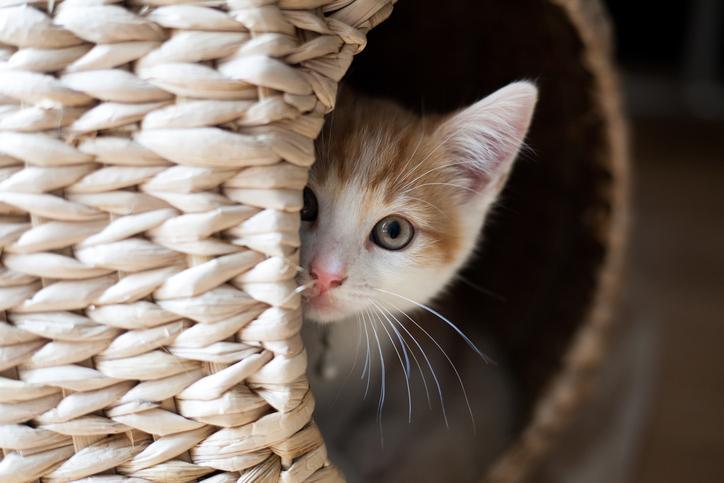How to Welcome Your New Cat Home



See files for Cats
Bringing a new cat home is a thrilling experience. But amidst the excitement, it is important to remember that your cat needs time to adjust. These first few days are crucial for building trust and laying the groundwork for a happy, lifelong bond. Also, the first days are a golden opportunity to gently introduce your kitten to positive routines and expectations.
The following AnimalWised article provides essential tips to welcome your new cat home and ensure a safe environment for your new feline pet.
1. Give your cat time to adjust
Before diving into our tips for your cat's first days, let's talk about something essential: respecting their adjustment period. Just like any creature, adapting to a new home takes time for cats.
Be patient and understanding during those early days. It's completely normal for your feline friend to feel shy, confused, or even scared. New sights, sounds, and smells can be overwhelming. This might lead to hiding, avoiding interaction, or seeking comfort in their new haven.
A new environment is a big change, and rushing the process can cause stress and anxiety. This can manifest in behaviors like hiding, hissing, using the litter box outside the box, or scratching furniture.
While you might be bursting with love and eagerness to play, the initial days are best spent creating a safe space. Let your cat initiate contact and respect their boundaries. This patience will be rewarded with a happy, confident, and well-adjusted cat who thrives in your loving home.
How long does it take for a cat to get used to a new house?
The amount of time it takes for a cat to get used to a new house can vary greatly depending on several factors, but generally it takes anywhere from a few days to several weeks. Kittens tend to adapt quicker than adult cats, who may be more set in their ways.
Also, personality plays a big role, more confident and outgoing cats might adjust faster than shy or anxious ones. Besides, cats who have moved homes before may adapt faster than those who haven't.
2. Cat-proof your home
Before bringing your new cat home, it's essential to prepare the environment for its arrival. Each cat needs its own space where it feels comfortable and safe to rest and start getting used to its new surroundings.
This space should include basic items like a litter box, water bowl, food bowl, bed or resting spot, scratching post, toys, and other accessories that improve its quality of life. This setup will help your kitten feel welcome and support its adaptation process.
If you already have another cat at home, make sure each cat has its own resources to avoid fights and possible accidents. Cats should not feel forced to interact or share their territories, so each one needs its own space. Additionally, you'll need to provide an extra litter box. Pay special attention when introducing your new kitten to your resident cat to encourage positive interactions. Over time, as they socialize and get to know each other, you'll notice them becoming curious and starting to interact.
Remember to keep feeding, grooming, resting, and play areas separate from each other. This helps maintain better hygiene and respects your cat's needs.
Discover the subtle signs that might indicate your new cat is feeling stressed, and learn how to create a calming environment for them.
3. Schedule a vet visit for a checkup
When adopting a kitten or adult cat, it's important to take it to the veterinarian for a health check-up. This visit should include starting or updating its vaccination and deworming schedule.
While there are many benefits to adopting a stray cat, it’s crucial to remember that animals born or living on the streets are exposed to various pathogens. As a result, stray cats can transmit certain diseases to humans and other household pets.
To ensure the health of your new cat, yourself, and your family members, it’s essential to provide proper preventive care for your cat throughout its life. This approach helps prevent or detect early the most common diseases in cats, which can significantly affect their well-being.

4. Meet your cat's changing nutritional needs with a balanced diet
A cat's dietary requirements shift throughout their life, just like their energy levels and activity patterns. Kittens have rapidly developing bodies and require a specific diet to support their growth and health. The following information outlines key considerations for kitten nutrition throughout different stages:
Early development (birth to 2-3 months)
A kitten's primary source of nutrition during this period is its mother's milk. Mother's milk provides essential nutrients, including protein, fats, carbohydrates, vitamins, and antibodies, crucial for building a strong immune system. Weaning typically occurs between 4-8 weeks of age. During this transition, kittens gradually shift from solely milk-based feeding to solid foods.
Choosing a kitten diet (around 2 months old)
Once kittens are weaned and ready for solid food (approximately 2 months old, sometimes 1.5 months), pet owners have two main dietary options:
- High-quality commercial kitten food: commercially available kitten food formulas are specifically designed to meet the nutritional needs of growing kittens. These foods provide a balanced mix of protein, carbohydrates, fats, vitamins, and minerals to support optimal growth and development. Look for kitten food labeled "complete and balanced" to ensure it meets all essential nutrient requirements. Choose reputable brands known for high-quality ingredients.
- Natural diet (BARF): the Biologically Appropriate Raw Food (BARF) diet involves feeding cats uncooked meat, bones, organs, and other raw ingredients. While some pet owners prefer this approach, it requires careful planning and research to ensure nutritional adequacy and safety. Consult a veterinarian before implementing a BARF diet to ensure it meets your kitten's specific needs and is prepared safely to avoid bacterial contamination. This approach may be more time-consuming and expensive than commercially prepared kitten food.
Regardless of the chosen diet, it's crucial to consult with a veterinarian to discuss your kitten's specific needs and health history. They can offer personalized recommendations on food selection, portion control, and potential dietary supplements to support your kitten's overall well-being.

5. Create a stimulating playground for a happy mind and a healthy body
Cats are intelligent, curious creatures who thrive on both physical and mental stimulation. To keep them happy, well-adjusted, and prevent stress, create an enriched environment that lets them exercise, entertain themselves, and hone their natural skills.
Environmental enrichment is all about enhancing your cat's quality of life. It goes beyond just providing food and water. Think of it as building a feline playground that stimulates their senses and keeps them engaged. Here are some ideas:
- Offer a variety of toys to satisfy your cat's hunting instincts. Include interactive toys like feather wands or puzzle feeders, and rotate them regularly to keep things interesting.
- Provide scratching posts and climbing structures that allow your cat to explore vertical spaces and fulfill their natural desire to climb.
- Include hidden cubbies or boxes for your cat to retreat to when they need a quiet space to relax or feel secure.
- Consider incorporating catnip toys, cat grass, or even interactive games that stimulate sight or sound. These can help your cat develop their senses and stay mentally sharp.
While providing enrichment is key, it's important not to overwhelm your cat. Start with a few essentials and gradually introduce new items. Ensure there's enough space for your cat to move freely and navigate their environment without feeling cluttered.
Ready to unleash your kitten's playful side? Discover the 5 toys guaranteed to make your feline friend purr with joy.

6. Learn your cat's body language
Welcoming a kitten into your home is an exciting adventure. To help your new friend feel safe and secure, it's crucial to build a strong bond based on trust and affection from the very beginning.
Every cat has its own unique personality. Take some time to observe and understand your kitten's preferences. This will help you approach them in a way they find comfortable. Understanding your kitten's postures, actions, facial expressions, and sounds is essential for deciphering their moods and needs. A slow blink signifies comfort, while a swishing tail may indicate irritation.
Once your kitten feels comfortable and ready to interact, it's playtime! Here are some ways to strengthen your bond:
- Engage your kitten's natural hunting instincts with interactive toys like feather wands or puzzle feeders.
- Schedule dedicated cuddle sessions or playtime to create positive associations with your presence.
- Unlike dogs, cats cherish their alone time. Respect their need for quiet moments and enjoy watching them purr peacefully.
Now that your new cat feels at home, it's time to learn their language! Discover how to decode their body language and understand what your feline friend is trying to tell you.

7. Socialize your cat for balanced behavior
Raising happy, well-adjusted cats goes beyond just food and cuddles. Both training and socialization play vital roles in shaping your feline friend's behavior and ensuring a harmonious life together.
Contrary to popular belief, cats are intelligent creatures who can learn. Starting training from a young age fosters positive behaviors and helps your kitten understand what's expected. Use rewards like treats, praise, and petting to encourage desired behaviors like using the litter box or scratching on a post. This builds trust and positive associations with training.
It is also important to address inappropriate behaviors like biting, scratching furniture, or jumping on counters early on. Redirect their attention to appropriate toys or scratching posts and avoid punishment which can damage the bond.
Just like humans, cats thrive on social interaction. Proper socialization helps kittens learn to interact confidently with people, animals, and different environments. A well-socialized kitten will be more comfortable with guests, less likely to exhibit fear-based behaviors like hiding or hissing, and will adapt more easily to new situations.
While ideal to start young, even adult cats can benefit from socialization. With patience and positive experiences, they can learn to adjust and feel comfortable in their surroundings.

If you want to read similar articles to How to Welcome Your New Cat Home, we recommend you visit our What you need to know category.










